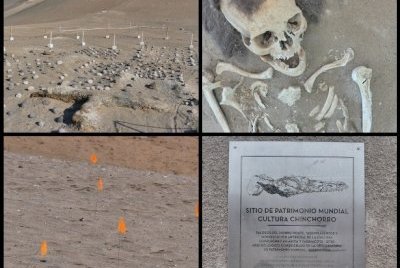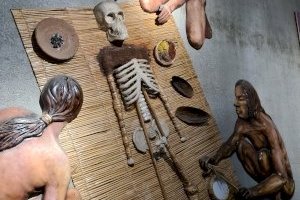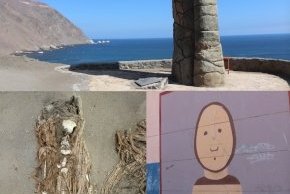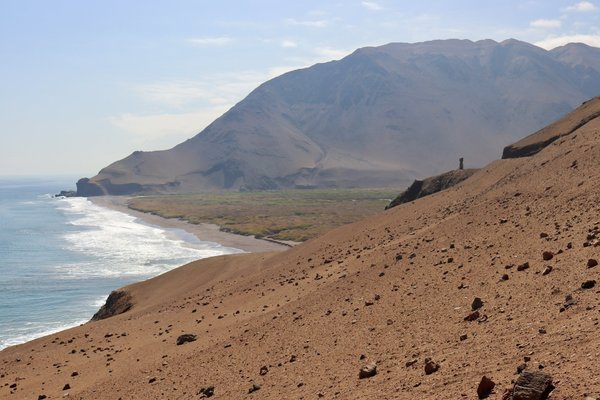Chile
Chinchorro Culture
The Settlement and Artificial Mummification of the Chinchorro Culture in the Arica and Parinacota Region represent the long-practiced mortuary techniques and associated beliefs of this Pre-Columbian civilization.
The Chinchorro were marine hunter-gatherers who lived in these coastal areas of the arid Atacama Desert from 7,400 BP to 2,840 BP. They are known for their advanced mummification practices, and the oldest known artificially mummified human bodies have been found here. The area illustrating the Chinchorro habitat also consists of settlements, cemeteries, and shell middens.
Community Perspective: This site has 3 components, and Walter visited them all. Colon 10 in Arica is the location where you can get the closest to the mummies. Timonator recommends staying in the hotel "Le petit clos" opposite for a close but controversial encounter.
Site Info
Official Information
- Full Name
- Settlement and Artificial Mummification of the Chinchorro Culture in the Arica and Parinacota Region (ID: 1634)
- Country
- Chile
- Status
-
Inscribed 2021
Site history
History of Chinchorro Culture
- 2021: Advisory Body overruled
- ICOMOS advised Referral
- 2021: Inscribed
- Inscribed
- Type
- Cultural
- Criteria
- iii
- v
Links
- UNESCO
- whc.unesco.org
- Official
-
- eligecultura.gob.cl — Site museum of Colón 10
All Links
UNESCO.org
- whc.unesco.org — whc.unesco.org/
Official Website
- eligecultura.gob.cl — Site museum of Colón 10
News Article
- March 26, 2022 theguardian.com — Chile’s archaeologists fight to save the world’s oldest mummies from climate change
Community Information
- Community Category
- Archaeological site: Pre-Columbian
Travel Information
Recent Connections
-
Hyper-arid
"They successfully adapted to the extre… -
Longest WHS names
The Settlement and Artificial Mummifica… -
Affected by Climate Change
The Atacama's dry weather has helped pr…
Connections of Chinchorro Culture
- Individual People
-
-
Female Archaeologists
Vivien Standen - Between January and March 1984, Vivien Standen took over the excavations at the Morro 1 Site, recovering another 73 complete and incomplete individuals. Standen also studied the Colón 10 Site between 2004 and 2010. (Chinchorro Culture Nomation Text, p. 163, 166) -
Max Uhle
Nearly one hundred mummified individuals were excavated there by German archaeologist Max Uhle, who proposed the first typology of bodies with artificial treatment. (AB ev)
-
- Geography
-
-
Desert Cultural Landscapes
The property is made up of the places where the Chinchorro groups coexisted in equilibrium with their desert environment, which in itself is perhaps what made their complex forms of expression possible. (Chinchorro Culture Nomination Text, p. 88) -
Pacific Ocean
Component 1 and 3 border the Pacific Ocean
-
- History
-
-
Pre-Inca cultures
Chinchorro culture -
Archaeological 'Type Sites'
The Chinchorro type site is located in Arica, Chile; it was discovered by German archaeologist Max Uhle in the early 20th century.See en.wikipedia.org
-
Sieges and Battles
The Morro del Arica was the site of the battle in which Chile captured Arica from Peru during the War of the Pacific in June 1880.See en.wikipedia.org
-
Shell Mounds (Middens)
dense shell middens (AB ev)
-
- Ecology
-
-
Lagoons
In the area surrounding the mouth of the Camarones River, current surface run-off conditions generate a small lagoon adjacent to the beach area, where the wetlands are located. (Chinchorro Culture Nomination Text, p. 130) -
Hyper-arid
"They successfully adapted to the extreme environmental conditions of a hyper-arid coastal desert" (OUV)
-
- Damaged
-
-
Affected by Climate Change
The Atacama's dry weather has helped preserve the Chinchorro mummies for thousands of years, but some have rapidly deteriorated in the past decade, their skin melting into black ooze. According to Harvard scientists, climate change is causing microorganisms to attack the mummies' collagen. Stronger El Niño currents are behind the region's increasing humidity, meaning the mummies are endangered whether they're in a museum or buried in the desert.
-
- World Heritage Process
-
-
Reduced from broader TWHS
The broader TWHS (Archaeological sites of the Chinchorro culture) included a location in Antofagasta as well
-
- Human Activity
-
-
Textiles
In river mouth environments, an important diversity of species emerges when there is good irrigation, forming wetland areas locally known as chimbas. In these wetlands, abundant swordgrass and southern cattails can be found, the main components of diverse Chinchorro textiles. The characteristics of these wetlands can still be seen today (...) in Camarones, in areas that have suffered little intervention and are closely associated with the remains of the Chinchorro occupation. (Chinchorro Culture Nomination Text, p. 91) -
Hunter-gatherers
The Chinchorro were a society of marine hunter-gatherers who lived between 7400 BP and 2840 BP approximately. (Nomination Text, p. 17) -
Mummies
The Chinchorro innovated continuously in their mummification practices to create artificial mummies that possessed extraordinary material, sculptural, and aesthetic qualities (AB ev) -
Masks
The faces of the mummies received artificial treatment, like mud or clay masks. (Chinchorro Culture Nomination Text, p. 111-113) -
Geoglyphs
Two geoglyphs from the Late Period have been found at the mouth of the Camarones River. The first is located inside the valley, six kilometers from the mouth of the river and is made up of a panel of camelid figures. The second is a circular figure located at the top of the southern slope of the river mouth, created using a subtractive technique and with red pigment on its borders. Both geoglyphs are related to trails that connect the river mouth to the middle of the Camarones Valley. (Chinchorro Culture Nomination Text, p. 143) -
Ongoing Archaeological digs
Studies of Chinchorro archaeological sites at the mouth of the Camarones River have been carried out as a result of research initiatives initiated at the end of the fifties and continue to this day, motivated by different research aims that intend to reveal the presence of the territory's intense occupation. (Chinchorro Culture Nomination Text, p. 157)
-
- Constructions
-
-
Cemeteries
the archaeological remains of ... cemeteries (AB ev)
-
- Timeline
-
-
Built in the 6th millennium BC
Chinchorro, a society of marine hunter-gatherers who lived here from approximately 7,400 BP to 2,840 BP (5,450 BCE to 890 BCE).
-
- Science and Technology
-
-
Archaeological potential
At present, both the settlement and the artifactual evidence in situ below the surface in the Desembocadura de Camarones area are intact and a potential source of scientific information for both the present and the future. At domestic sites such as Conchal Sur, Camarones 14, Camarones 17, Camarones 1, Camarones 2 and Camarones 8, the possibility of future studies into the relationship between different populations and between them and their surroundings is assured. (Chinchorro Culture Nomination Text, p. 184) -
Recently discovered
The Colón 10 site is a cemetery that was discovered in 2004 during an excavation to salvage the interior of the house located at N° 10 Colónstreet. It was decided to leave the bodies in situ and design a site museum around them. (Chinchorro Culture Nomination Text, p. 126) -
Recorded cultural discoveries
The Chinchorro type site is located in Arica, Chile; it was discovered by German archaeologist Max Uhle in the early 20th century. He excavated nearly a hundred individuals during the twenties.See en.wikipedia.org
-
- WHS Names
-
-
Longest WHS names
The Settlement and Artificial Mummification of the Chinchorro Culture in the Arica and Parinacota Region – 104 letters
-
News
- theguardian.com 03/26/2022
- Chile’s archaeologists fight to sa…
Community Reviews
Show full reviews
I visited this WHS in 2023 visiting all 3 locations. Arica in Northern Chile is a dusty town, very close to the Peruvian border (it also experiences the infamous "Garua" overcast weather at times!). Apart from the pretty Cathedral of St. Mark designed by Gustave Eiffel and built in the 1870s, the highlight in town for WH travellers lies in the vicinity of the Morro de Arica Natural Monument.
As a WH traveller I was more keen on exploring its cultural and prehistoric importance rather than its natural importance or its more recent military importance. Half way up the Morro de Arica Natural Monument, you'll be able to spot the fenced off archaeological site of the Faldeo Norte del Morro de Arica, the first location I visited. There isn't much to see at the moment, apart from orange flags and plots marking ongoing digs. At the bottom, at street level, there is the UNESCO WHS inscription plaque.
By the time I took in the view from the top and explored the first location, the next location I wanted to visit, Colón 10, had opened and I was the first to enter (and the only one for that matter till the end of my visit). A kind old lady indicated the QR code available for interesting information and videos on the site. This central archaeological dig is practically hidden in what would easily seem like any other house along the steep street. Clean glass floors make it easy to …
Keep reading 0 comments
The WHS consists of three components of which 2 are almost next to each other and in my opinion could be the same component. I can recommend staying in the hotel "Le petit clos" opposite of the museum and site "Colón 10". In the museum over 40 remainings of the Chinchorro people are displayed. The skeletons were found in 2004 when a hotel was supposed to be constructed in this place. They are over 2000 years old a give some ideas on the burial practices and life of the Chinchorro people. Some skeletons have mussels and sea snails as presents next to their bones. Others have human hair and red colour on hair and bones. There is a very good 28 minute audio guide leading through the excavation. It was even available in (very good) German. The hotel and also the museum are basically all part of the north front of the "Murro", the big hill next to the Pacific in Arica. It is inscribed as well as WHS because it is full of Chinchorro bones as it has been used as burial site by the culture. Surely the Colon 10 seems like a cemetery however from my point of view it's only part of the whole Morro north site which is an even bigger cemetery. Our host Daniel showed us that he can access parts of the UNESCO excavation side from his backyard. Currently no works are being done there. Just by walking here we found a lot of …
Keep reading 0 comments
The property centers around the Chinchorro people who lived in the arid coastal area of the Atacama Desert (in northern Chile and southern Peru), from around 5000 BC to 1000 BC. They were marine hunters-gatherers and are known for having left behind the oldest know artificial mummification of bodies (predating the Egyptian mummies). The Chinchoro mummified all the dead, including children and even miscarried fetuses.Over the centuries, the mummification process complexified with dismembering and reassembling the bodies and the use of artificial clay face masks. The mummies have become a landmarks in the area around Arica, with monumental statues figuring the mummies in many places, among them along the Highway 10, and many urban street art depicting them (statue in Desemboca top picture; street art on Morro de Arica bootm right picture)
I visited the three components of this property in June 2022. The two first are within Arica city limit, so are easy to visit. The third more of less necessitates a car to be reached.- The northern face of the Morro de Arica: located on the slope of a hill above the city of Arica. Cemeteries where found and excavated. Nowadays, not much remains, except a look at the arid desert soil and an exceptional view over the city of Arica and the plains beyond. - Colón 10: a small museum, next to the Morro de Arica, preserving in situ an old cemetery. It was discovered in 2004 while reconstructing a house on the …
Keep reading 0 comments
